
The History of Tarot ~ 900ce to the Present
Shellay Lynne Maughan 2023 all rights reserved
10th century China - The invention of Cards


18th Century Qing Dynasty Woodcut Playing Cards
Playing cards were invented in China during the T'ang dynasty (618-906), along with the invention of paper and woodblock printing. None of these earliest cards survive, but we know of their existence from written references.
For example, on New Year's Eve, 969, memoirs mention the Emperor Mu-tsung playing "domino cards" with his wife. These cards are thought to closely resemble surviving 13th century examples, and are very similar to cards still used today

13th Century, Ming Dynasty, found near Turpan
Egypt and Turkey; The Mamluks

Only a century later, playing cards were well known throughout Asia, and had followed the trade routes into Persia, Turkey, and Egypt.
The oldest surviving cards are Arabic and come to us from Egypt in the era of the Mamluk Sultanate; these include four fragments dated to the 12th and 13th century, and a near complete deck found in a Mamluk palace in Turkey, dating to the 15th century.
The Mamluk cards are the earliest surviving example of card decks with the structure we still follow today; 52 cards in four suits of ten cards and three court cards.
This fragment is dated to around 1300, although the dating, based on the artistic style of a very small fragment, is uncertain. It consists of the top right corner of a card, possibly the four of cups.


This nearly complete deck, known as Mulūk wa-nuwwāb (Kings and Deputies) is held at the Topkapı Palace Museum in Istanbul. It is presumed to have originally contained 52 cards, of which 43 survive.
Five cards were lost early in it’s history and replaced by cards from two similar decks. At that time several of the cards from the primary pack were also altered.
Many of the Mamluk cards are decorated with poems along the tops and bottoms that are clearly predictions of one’s fortune, or advice:
“With the sword of happiness I shall redeem a beloved who will afterwards take my life.“
“I will, as pearls on a string, be lifted in the hands of kings”
“Look how wonderful my game is and my dress extraordinarily beautiful”
“The alif rejoices and fulfils your wishes”
“O my heart, for thee the good news that rejoices”
“Rejoice in the happiness that returns, as a bird that sings its joy”.
Playing Cards Enter Europe ~ 1365-1390
Mamluk style cards reached both Italy and Spain by 1365, and were widespread throughout Europe by 1390. Polo sticks became clubs, spears, or arrows. The court cards become king, knight, and valet. Queens appeared sporadically but were not common at this point. Figures start to appear on the court cards.

Some Places Cards did not Come From
There are a number of other origin theories, now considered to be discredited:
-
Marco Polo is unlikely to have brought back cards from his voyage to China, as he returned in 1293.
-
The Crusades also ended too early. around 1291.
-
There is no evidence that cards were brought from either India or Egypt by the Roma (gypsies).
Early Tarot ~ Italy 1420-1475
While cards entered Europe via both Italy and Spain, tarot developed in Italy.
Tarot began as a card game called Trionfi or Tarocchi, invented around 1400, and well known by 1420.
Tarocchi had a fifth suit called the ‘trump’ suit, in addition to the normal 4 suits, and usually included a queen. As a popular pastime of the aristocracy, Tarocchi was made a ‘Permitted’ game in 1450, undoubtedly helping ensure it’s widespread popularity.

Visconti-Sforza - The Illuminated Decks

Rothschild-Bassano
It was the Italian aristocracy, and most especially the great houses of Milan and Ferrara, who developed the tarot deck as we know it today. They commissioned elaborate hand painted and gilded decks as gifts and to commemorate important events such as weddings and coronations.
We use the term Visconti-Sforza tarot to refer to 15 incomplete decks, now named after the collections they are held in. Most are thought to have been commissioned by Filippo Maria Visconti, Duke of Milan, or by his successor and son-in-law Francesco Sforza, all between 1441 and 1463.
It was in these decks where the illustrations for the trump suit becomes standardized, likely based on Petrarch’s poem I Trionfi, and the Trionfo; theatrical processions that were popular in the Italian Renaissance. This pattern set the norm for tarot.
The Cary-Yale Visconti-d’Madrone
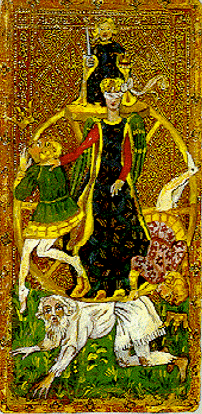


No complete deck survives, but a few come close. The oldest of these is thought to be the Cary-Yale Visconti-d’Madrone deck, produced sometime between 1441 and 1447. 67 cards are still in existence, out of the original 86. They are held in Yale University's Cary Collection of Playing Cards.
Tarot was not yet standardized, and the Cary deck has six face cards, with a "Damsel" and a "Lady on horse" as well as the traditional King, Queen, Knight and Page.



Pierpont Morgan Bergamo 1450
This deck, commissioned in 1450 by Francesco Sforza, is published as the Visconti-Sforza. Nearly complete, although a few cards from another deck were added at some point, presumably to replace lost cards. Only four cards are missing: Tower, Devil, Knight of Coins, and Three of Swords.
There are no original Tower or Devil cards still in existence from any of the illuminated decks. In modern reproductions these cards are always new,

current day additions. It is believed that these cards were originally included, as they exist in mass produced decks from the same time period.
Brera-Brambilla 1463


Francesco Sforza commissioned Bonifacio Bembo to paint this deck in 1463. 48 cards survive, of which only two are trumps - the Emperor and the Wheel of Fortune.
Every card in the deck is gilded; all trumps and face cards have a gold background, while the pip cards background is silver.
Printed Tarocchi
Alongside the expensive, hand painted illuminated decks of the aristocracy, tarot was also played by ordinary people. Inexpensive wood-block printed tarocchi decks were available as early as 1424, and were being mass produced by 1442. The d'Este court at Ferrara had their own printing press for making cards. None of these cards survive as decks. What we do have are a few uncut sheets of cards, found in the bindings of books.

Paper was expensive. Bookbinders used leftover sheets of paper to reinforce book covers, including sheets of tarot cards discarded due to printing errors. When old books are restored, we find these sheets. In this way some of these fragile old cards are preserved.
These early decks already included the now- traditional trump cards, with iconography still familiar today
Ferrara, 1500, Budapest Metropolitan Museum
Rosenwald Sheet, Ferrara 1480-1500
Three uncut sheets of tarot cards, part of the Rosenwald collection held by the National Gallery of Art, Washington DC. There are no numbers or titles, but the illustrations are clearly proto- Marseille. There are no illustrations on the pips.

Cary Sheet Early to Mid-1500s
Uncut sheet of 20 proto-Marseille cards; Wheel of Fortune, Chariot, Love, Fortitude, Popess, Emperor, Empress, Pope (?), Sun, Moon, Star, Bagatto, Fool (?), Tower, Devil, Temperance.
Batons from separate sheet and mounted to appear as part of this sheet. Only 6 cards are complete: Popess, Emperor, Empress, Moon, Star, and Bagatto.
Not to be confused with the Cary-Yale illuminated deck, this sheet is held in the same collection; the Cary Collection of Playing Cards at The Beinecke Rare Book and Manuscript Library, Yale University.

Rothchild sheet 1500 (approx.)
An incomplete fragment of 20 uncut proto-Marseille cards, of which only 6 are complete. From the Rothchild collection in the Louvre, Paris.

Sola Busca 1490
Outside of the Visconti/Sforza/d’Este illuminated decks, tarochhi was illustrated at the whim of the artist, with flowers, animals, and a variety of historic and mythological figures. There was no set order to the cards or standard subjects.


A good example of this is the deck now known as Sola Busca, after the family that owned the best surviving copy. This is an astonishingly well preserved, complete deck utilizing heroes, rulers and gods.
Even the minor cards are fully illustrated
with figures.
This is the oldest surviving complete tarot, and the oldest deck where we are certain the standard configuration of 22 trumps, 40 pips and 16 courts cards is used
Printed from copperplate engraving in Venice in 1490, at least one deck was hand painted, probably in 1491. This deck, owned by the Sola Busca family, is the only known full color example.Other fragmentary decks are preserved in public and private collections, but none are in color.
It’s been convincingly argued that the illustrations are alchemical allegories, lending weight to the idea that tarot trumps were used to convey occult and philosophical ideas.
23 black and white Sola Busca cards were acquired by the British Museum in 1845.
In 1907 the family Busca-Serbelloni donated black-and-white photographs of all 78 cards in their full color deck the British Museum.
These photographs were placed on exhibit, where they directly inspired a number of the Rider Waite-Smith lesser arcana cards.


Other Decks with Illustrated Minor Cards
As an aside, while the Sola Busca is the only tarot deck with fully illustrated pips until the Rider- Waite-Smith in 1909, cards were illustrated to a high degree in other types of decks. For example, this is the 53 card Jost Aman deck from Nuremberg, in the late 1500s.
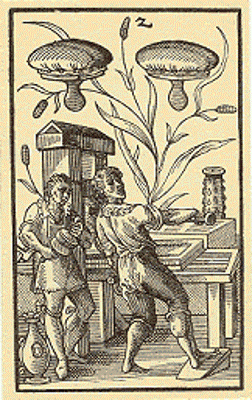
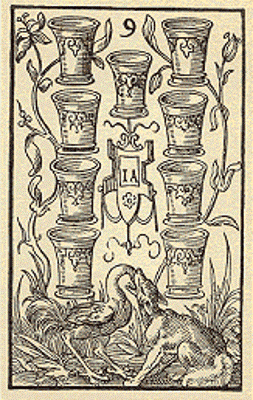
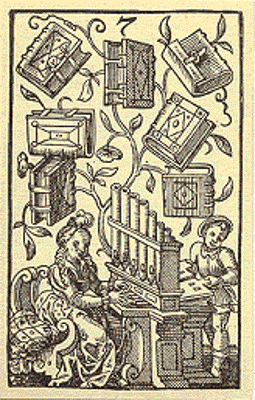
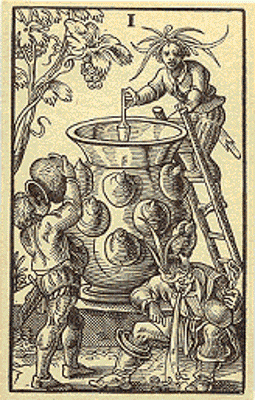
France 1500-1675

Between 1494 and 1559, Italy and France were in an almost continuous state of war. The creation of handmade illuminated decks ceased.
Printed card manufacturing began to shift from Italy to France, eventually becoming standardized in the Tarot de Marseille pattern.
Tarot de Marseille



Philippe Vachier 1639
The earliest surviving cards of the Marseilles pattern were produced by Philippe Vachier of Marseilles in 1639 and went up for sale in 2023, having recently been discovered by Thierry Depaulis. Thierry Depaulis noticed the Payen 1743 deck apparently uses the same woodblocks as the Vachier.
Jean Noblet 1650 (approx)
Paris. Jean Noblet published the first deck we know of that closely conforms to the Tarot de Marseille pattern. It is held in the collection of the Bibliothèque Nationale de France.
Numbered and titled trumps. The order of the cards is becoming standardized.


Tarot de Paris 1650 (approx)
This Parisian deck, commonly called the Tarot of Paris, is the oldest existing complete block printed deck that still contains all 78 original cards. Only one example has survived—a complete deck in the Bibliothèque Nationale de France. Cards are numbered, with titles on the trumps.
Nicolas Conver 1760
While not the oldest, this is the best known and most often copied of the early Tarot de Marseille. Printed in 1760 from woodcuts and colored using stencils, Convers and his heirs continued to print these decks using the same templates and colors for more than a century.
In 1880 new plates were created and the deck began to be printed in the industrial four color process, significantly altering the colors beginning with the 1880 edition.



Esoteric Tarot - France, 1781 to 1910
This was a pivotal time in the history of Tarot.
While tarot continues to be played as a game to this day, Gnosticism, alchemy, astrology and an Esoteric Christian version of Kabbalah came together in the esoteric lodges of 18th century France to remake tarot into the occult guide and divinatory tool we know today.
Especially, we must look to the Masons, as French occult circles were essentially Freemasonic.

Antoine Court de Gébelin 1781
Antoine Court de Gébelin was an influential French writer and thinker, a former Protestant pastor, and a Freemason. He believed that the ancient world was wiser and more spiritual, and that all language, symbolism, and religion originally came from one unified source. He published a nine volume ‘History of the World’, full of these ideas, that continues to influence occult thought today.
History of the World included a 1781 essay explaining that the tarot was a repository of timeless esoteric wisdom in symbols, based on an Egyptian holy book called the Book of Thoth, which was created by Egyptian priests and brought to Europe by Gypsies in the 14th century. This of course was pure fantasy, but was widely believed.

This volume also included an essay by the Comte de Mellet that proposed a mystical connection between the Tarot trumps and the 22 letters of the Hebrew alphabet.
Etteilla (Jean-Baptiste Alliette)

Jean-Baptiste Alliette was a French occultist who published under the pseudonym Etteilla – his last name spelled backwards.
It was Etteilla who first popularized tarot as an occult and divinatory tool to a wide audience; he ran a tarot school, including correspondence courses, and published the first book on how to read tarot.
His school eventually died out but his teachings still have tremendous influence. His divinatory card meanings greatly influenced the English occultists S. L. MacGregor Mathers and A.E. Waite, and they were used as the meanings of many Rider Waite Smith cards.
Etteilla developed a number of ideas we take for granted today; the significator card, reversed meanings, and the idea of using a layout of only a few of the cards rather than the whole deck.
He was the first to use the terms ‘Major’ and ‘Minor’ arcana – or secrets, as well as linking the four elements and astrology to the cards.

His first deck, published in 1770, used a modified 32 card piquet deck, as this was the type of deck most often used for divination in France at the time, and is the ancestor of the Lenormand and other oracle decks. He included meanings on each card.
Like most of French society, Etteilla was
fascinated by the ideas in de Gebelin’s encyclopedia.
In 1788 he created a new deck, Le Grand Etteilla, combining de Gebelin’s ideas with his own interpretations, and a bit of traditional French cartomancy.
Although it does not follow the pattern established for Tarot, especially in the design of the trumps, Le Grand Etteilla is the first specifically occult deck. This deck, and his book ‘Theoretical and practical course of the book of Thoth’ turned tarot and divination into an esoteric pursuit.
No known copy of Etteilla’s original tarot deck has survived. Even the cards printed from his original copperplate engravings were slightly altered after his death.

We know his deck through the descriptions published in his books. A number of modern versions have been created based on those descriptions.

Eliphas Levi (Alphonse-Louise Constant)
It’s not an exaggeration to say that the whole of western ceremonial magic stems from Lévi's 1856 book Dogme et Rituel de la Haute Magie (The Doctrine of Transcendental Magic). In every branch of modern magic and occultism you will find Levi, if not by name than by influence.
Lévi wrote that
“... without the Tarot the Magic of the ancients is a closed book, and it is impossible to penetrate any of the great mysteries of the Kabalah."
And
“An imprisoned person with no other book than the Tarot, if he knew how to use it, could in a few years acquire universal knowledge, and would be able to speak on all subjects with unequaled learning and inexhaustible eloquence."

Levi taught that divination is a vulgar, or lesser, use of tarot. He was particularly scathing in his low opinion of Etteilla and his divination school.
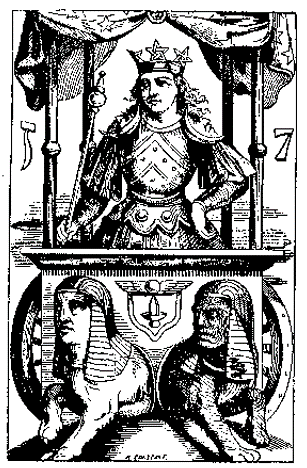
Transcendental Magic includes sketches and descriptions of the
major arcana, but Levi didn’t create a tarot deck, as he published only the major archana images, and only in book form.
He is the source of many of the core ideas and attributions widely used today:
-
Inspired by de Gebelin’s association of the Hebrew alphabet with the Tarot trumps, and the Christian Cabala of Athanasius Kircher, Levi placed all 78 cards on the tree of life.
-
Linked the court cards to the stages of human life
-
Assigned the four suites to the letters of the Tetragrammaton.
Levi’s ideas were the basis for Liber T, the source of the Golden Dawn tarot teachings and the bedrock of esoteric tarot in the English-speaking world.
Paul Christian (Jean-Baptiste Pitois)
Ancient Egypt as the source of tarot was a popular idea from the start, but it’s survival in modern tarot decks can be traced back to Paul Christian.
In his books he describes 78 Egyptian Tarot cards. (1863 Red Man of the Tulleries, 1870 The History of Magic) These were popular, fanciful works that took hold of the public imagination.
His card descriptions form the basis for decks still
in print today, most notably Falconnier’s 1896
Hermetic tarot, C. Z. Zain’s 1930s Brotherhood of
Light tarot, and innumerable modern decks.

Brotherhood of Light Tarot
Oswald Wirth

A redesigned version of the deck was published in 1927 as illustrations in Le Tarot des Imagiers du Moyen Age (Tarot of Medieval Artists), his compendium of occult and cabalistic tarot.
This 1927 edition was not published as a deck of cards, but included eleven lithographs, two cards to a sheet, in a folder added to the back of the book.
Joseph Paul Oswald Wirth was a Swiss occultist, artist and author. Working with Stanislaus De Guaita, in 1889 he designed a major arcana based on Levi’s interpretation of the Tarot de Marseille, published in a limited edition of 350 hand painted copies.
Wirth only illustrated the major arcana, as his tarot is an interpretation of Levi, who did not write about the minor arcana.
There are modern ‘Wirth’ decks available that include a minor arcana, but the minor cards in these decks are not Wirth designs.

Papus (Gerard Encausse)
Gerard Encausse was an occultist and author, a bishop in Doinel’s Gnostic Church of France, a member of the Hermetic Brotherhood of Light and the Hermetic Order of the Golden Dawn, an advisor to Tsar Nicolas III, a medical doctor, and a member and/or founder of several irregular masonic organizations.
Papus published his best know book, Tarot of the Bohemians, in 1889, and illustrated it with line drawings of the Tarot de Marseille (specifically, the Conver deck) and the deck designed by Wirth. This book presents a complete system of symbolism and correspondences, and is intended to synthesis the works of the occult writers who came before him, especially de Gautier and Levi.

In 1910 Papus published The Divinatory Tarot, this time with illustrations by Gabriel Goulinat. Both books were highly influential and are still in print.
The layout of the deck in The Divinatory Tarot appears to owe much to the Petite Etteilla.
Esoteric Tarot - England, 1887 to 1943
The Hermetic Order of the Golden Dawn
In 1887, English occultist William Westcott received a group of papers written in code, which had been the property of noted masonic scholar Kenneth Mackenzie. The origin of these ‘Cypher Manuscripts’ is obscure, although many stories and theories exist.
It was these manuscripts, decoded by Wescott, that formed the basis on which Westcott, William R. Woodman, and S. L. MacGregor Mathers founded the Hermetic Order of the Golden Dawn in 1888. Despite its Masonic roots, the order included women as well as men, and women were among the order’s leadership.

William Butler Yeats Golden Dawn Notebook
The Golden Dawn in its original form was active for only twelve years, from 1888 to 1900. Yet its teachings permeate modern western occultism, including tarot.
Among the cipher manuscripts was a detailed work on tarot symbolism, now commonly referred to as Book T.
Members were expected to draw and color their own tarot decks based on the descriptions in Book T. For this reason, there is no definitive original Golden Dawn deck. There are existing examples of members’ hand drawn cards, and a number of modern versions are available.
Book T
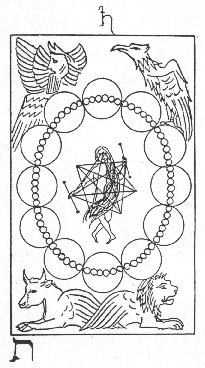
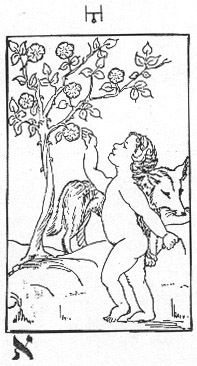

Whare Ra deck by Harriet Davidson Felkin
for the Stella Matutina.
The Rider Waite Smith Deck 1909
A. E. Waite and Pamela Coleman Smith
The Rider Waite deck was published in 1909, and the accompanying book The Pictorial Key to Tarot was published shortly after. They became the bedrock of Anglo-American tarot.
Although both Waite and Smith had been members of the Golden Dawn, they did not create a Golden Dawn deck.
Waite didn’t associate the cards with the

Hebrew letters or astrological attributions – in fact, the deck contains very few overt occult references, relying instead on pictorial symbolism.
The Rider Waite deck was published in 1909, and the accompanying book The Pictorial Key to Tarot was published shortly after. They became the bedrock of Anglo-American tarot.
Although both Waite and Smith had been members of the Golden Dawn, they did not create a Golden Dawn deck. Waite didn’t associate the cards with the Hebrew letters or astrological attributions – in fact, the deck contains very few overt occult references, relying instead on pictorial symbolism.
There are countless versions of the Rider Waite Smith deck, which entered the public domain in 1966, but a few are especially worth mentioning:
1917 The DeLaurence Company pirated the Rider Waite deck and Waite’s book The Pictorial Key to Tarot. For some time these decks were the only esoteric tarot available in the USA. They sold well and established the RWC outside of Britain.
1959 University Press produced an easily identifiable Rider-Waite deck with an ankh on the card backs. The colors are more vivid than later editions.
1970+ U.S. Games – this is the deck we most commonly see.
Continuously in print to this day.

2009, to commemorate Smith’s 100th birthday, U.S. Games issued a commemorative book and deck set based on a 1909 deck in a private collection.
Aleister Crowley and Lady Freida Harris
The Book of Thoth
In 1912, Crowley published the Golden Dawn’s Book T in The Equinox volume 1, number 8. The G.D. tarot correspondences and teachings became available to non-initiates for the first time.



Original color-test printing of the Ace of Swords 1943. In a private collection
The Thoth Tarot
The Thoth Tarot was designed by Aleister Crowley and
executed by Lady Freida Harris. The project took five years,
from 1938 to 1943. ‘The Book of Thoth: A Short Essay on the Tarot of the Egyptians’ was published in 1944 in The Equinox, volume III, number 5. What we now know as the Thoth Tarot are the illustrations for this book.
This major undertaking was completed near the end of Crowley’s life and reflects his seasoned thinking and accumulated knowledge.
There was no deck of cards printed to accompany the Book of Thoth, but it’s clear that Crowley intended there to be one as soon as time and funds allowed.
Seven color-test cards were printed in 1943 and are said to have been distributed by Crowley to potential investors. Some are known to still exist in private collections. They were printed using the collotype process, a costly and complicated method yielding very high quality color reproductions.
The Thoth deck uses the Golden Dawn’s Hebrew letter and astrological correspondences, except for the attribution of Tazddi. Crowley renamed Justice as Adjustment, Strength as Lust, Temperance as Art, and Judgment as Aeon. He switched Justice and Strength back to the Tarot de Marseilles order.
The collaboration between Crowley and Freida Harris was an active one. A major feature of the illustrations is the use of Projective Synthetic Geometry, or magical perspective, a technique taught by Rudolph Steiner that Harris explored constantly in her artwork.
Lady Harris’s paintings were displayed in a London gallery in 1942, but the deck wasn’t published
in a full color edition until 1969, after both Crowley and Freida Harris had passed on.
In the mid to late 1960s, Carr Collins of Sangreal Foundation and Simpson Printers published a very limited 250 copy single-color edition, known as the "Sangreal One Color Tarot". These cards were printed from photos of the black and white illustrations in the Book of Thoth.
The images were printed with blue ink, and the backs in red. The size of these cards was 5.5 x 3.75 (140 x 95 mm), which became the de facto standard for all large format Thoth decks.

Modern Tarot
Since the 1970s, the number of new tarot decks being designed and published has been explosive.

Two of the most interesting late 20th – early 21st century developments in tarot have been
-
The reprinting of historic decks. Famous card collections, such as the British Museum and the Cary collection at Yale, have allowed publishers access, and we now have accurate and beautiful copies of a host of important tarot decks.
-
The number and availability of new interpretations of this old symbolism, in both commercial decks and small, limited edition art decks.



Additional Reading, Online
By no means comprehensive, but these sites will get you started:
Historical playing cards: http://cards.old.no/
Aeclectic Tarot - Tarot Decks by Publisher: http://www.aeclectic.net/tarot/cards/publishers.shtml The International Playing Card Society: https://www.i-p-c-s.org/
52 Plus Joker, American Playing Card Collector's Club : http://www.52plusjoker.org/dnn/ World of Playing Cards, Illustrated history of Tarot: http://www.wopc.co.uk/tarot/index
Andy’s Playing Cards, traditional tarot decks and history: http://a_pollett.tripod.com/ Tarot Heritage, History and historic decks: https://tarot-heritage.com/
Mary K. Greer, Tarot History and Research: https://marykgreer.com
World Wide Playing Card Museum, hard to read site but many interesting things: http://a.trionfi.eu/WWPCM/
Additional Reading, Print
A Wicked Pack of Cards: The Origins of the Occult Tarot. Ronald Decker, Thierry DePaulis and
Michael Dummett.
Indispensable for understanding how Tarot became a metaphysical tool.
A History of Occult Tarot 1870-1970. Ronald Decker and Michael Dummett.
Sequel to the above book. Takes Tarot to the English speaking world. Information about the Golden Dawn, Mathers, and A.E. Waite.
Mystical Origins of the Tarot: From Ancient Roots to Modern Usage. Paul Huson.
Accessible history. Compendium of divinatory meanings from a range of historic sources.
Encyclopedia of Tarot, four volumes, Stuart R. Kaplan. US Games Systems. Stamford CT.
An indispensable resource, the definitive work on tarot history.
The Complete Guide to the Tarot. Eden Gray.
Unreliable history but an excellent resource for reading and interpreting the cards.